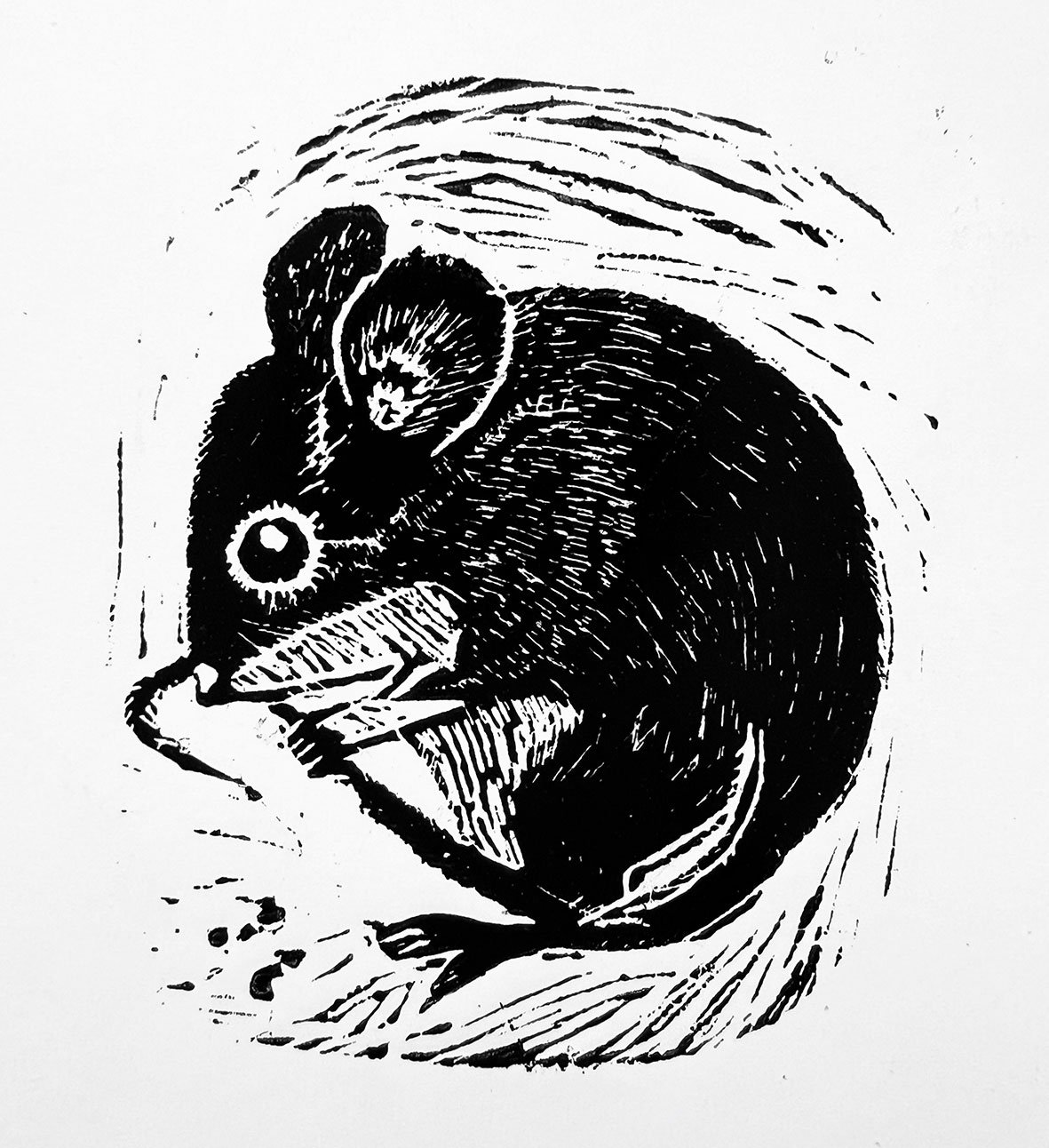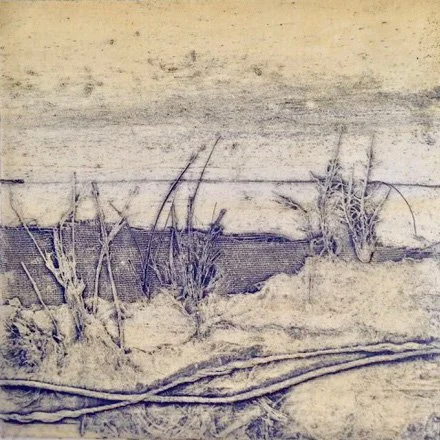PROCESS
Monotype
-
This is a one-off print, a unique impression printed off card, perspex, metal or any other flat surface; it cannot be repeated in identical form.
Typically, you would make a drawing in printing ink onto a Perspex, metal or card plate. When the drawing is complete and before the ink has time to dry, a sheet of paper is laid on top of the wet ink and transfers image from plate to paper via a printing press or by rubbing the back of the paper with a spoon. Monotypes allow the artist to work in a very spontaneous, direct manner and often have a painterly look.
Linocut
-
A print produced from a linoleum block, onto the surface of which the artist draws then cuts an image using fine steel gouges. The areas of the block to be inked and printed are left uncut (in relief) while the areas of the design not intended to take the printing ink are cut away. When the cutting is complete, a roller is charged with ink and passed over the surface of the block. This inks only the uncut surface and leaves the cut surface clean. Paper is laid flat down on the inked block and passed through a press under pressure which transfers the ink to the paper. The print is a mirror image of the cut block.
Although linoleum is a floor covering that dates to the 1860s, the linocut printing technique was used first by the artists of Die Brücke in Germany between 1905 and 1913.
Woodcut
-
This is perhaps the oldest printing process, first appearing over 1,000 years ago in China (c800 AD). An image is drawn onto a block of side-grain wood (plank). The artist then cuts away areas of the block that they do not want to take ink leaving, in relief, the intended image. Ink is then dabbed or rolled onto the block’s remaining uncut parts and the inked block is pressed onto paper. Printing can be done in a press or by hand or foot pressure, or by using hand-held burnishing implements such as a simple wooden spoon or a Japanese printing baren. The printed result is a mirror image of the design on the block. Tools used are usually steel gouges (U- or V-shaped cutting edges) or specialist cutting knives.
Collagraph
-
A collagraph is a print taken from a collaged plate. Different types of materials with different textures such as wallpaper, feathers, leaves, string, etc are stuck down onto a thick piece of card which is then varnished/sealed. When ready, the ‘plate’ is then inked up and printed (onto damp paper using a press) creating rich textures and an embossed surface.
The collagraph affords great freedom to an artist, collagraph plates are as simple or complex as the artist requires and can be developed as a specific printmaking process or combined with other printmaking techniques.
Etching
-
An etching is made by covering the surface of a metal plate with an acid resistant coating - the hard ground - through which the artist draws with a needle or similar point, exposing the bare metal. When the drawing is complete the plate is immersed in a bath of dilute acid which eats away the metal in the places that it has been exposed by the needle. The longer the plate is etched, the deeper the line. The deeper the line, the more ink it will hold and the blacker it will print. A range of line depths can be obtained during the etching process by either painting some out with varnish or by adding more lines, and returning the plate to the acid. When the plate has been fully etched the ground and varnish are cleaned off and it is ready to print. The term etching is used to describe any print made by an intaglio process.
Textures and tone can be created by using a ‘soft-ground’ The metal plate is coated with a pressure-sensitive, acid-resistant ground. Drawings can be done on thin paper on top of the ground. Where the pencil has pushed the paper into the soft ground, the ground sticks to the paper and is partially removed. Interesting effects can also be achieved by pressing various textured materials into the ground. The plate is etched in the same way as above.
Photopolymer Printmaking
-
Photopolymer intaglio is an innovative and relatively new etching process. It allows the artist to produce photographic and digital images (as well as more traditional hand drawn artwork) as original prints with the quality of hand printed etching. Transparent positives are exposed using a U.V light box, on to a photosensitive covered thin metal plate (Toyobo), etched in water and printed in the same was as traditional etching.
Screen Printing
-
Screenprinting is basically a stencil process. Printing using a frame stretched with a fine taut mesh through which ink is forced onto paper beneath. Areas of the screen are masked off using handmade/hand-drawn or photographic stencils to define an image. Ink is dragged over the stencil on the mesh using a long rubber blade called a squeegee. The squeegee forces an even distribution of ink to pass through the open areas of the stencil and onto the paper/other material.
Multi-colour images are created by using a different screen with a new stencil for each colour. Photo stencils are now the most commonly used. In this method, a drawing is made on a sheet of grained acetate using photopaque paint or digitally produced positive. As a separate transparency has to be made for each colour, these sheets are known as separations. The screen is coated with light-sensitive emulsion and placed on top of the separation in an exposure unit, which creates a vacuum to ensure perfect contact and exposes the screen to ultraviolet light. The opaque painting protects the emulsion behind it from the light, allowing it to remain soft, whilst the rest of the emulsion hardens. The screen is then washed out with water to dissolve the soft emulsion, leaving open areas of mesh through which ink can pass.
The technique was popularised as an artists’ medium by American Pop artists Andy Warhol and Roy Lichtenstein in the 1960s, though the basic technique seems to date back to c500 BC in Japan.







